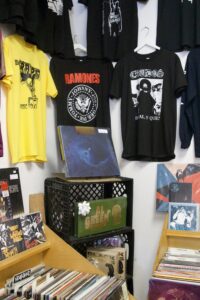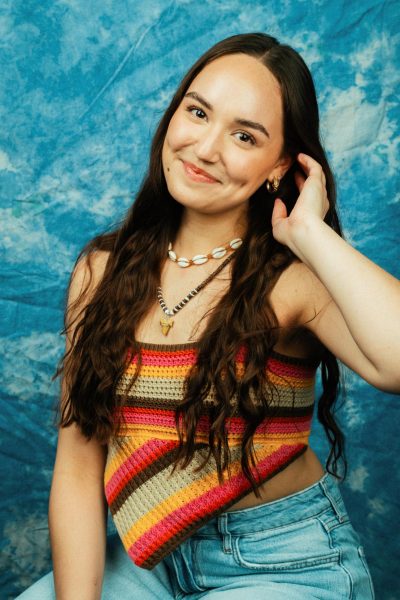Sidewalk surfing, cruising, skateboarding. Whatever you call it, skateboarding has been around for decades and it remains a central part of SoCal culture. The sport was invented by surfers who wanted something to do when the waves were flat. Now, it has become a large community of people who share a love for the lifestyle. Skating can influence the music they listen to, the films they watch or even the clothes they wear. Skate fashion cannot all fit into one category, but if you hit up the skate parks around Orange County, you’ll see three main looks: Surf, Street, and Punk.

Orange County’s Huntington Beach is known as Surf City USA, a hotspot for numerous surf events all year long. A majority of surfers in OC are also skaters, which influences how they dress. Surf skaters often wear brands like Hurley, Billabong and Quiksilver/Roxy. They wear loose shorts, and thin, light short-sleeved shirts with slip-on Vans.
Elijah Morley is a 20-year-old surfer and skater based in Costa Mesa. He started skating at a young age before he started surfing. “I’m good at balance sports, so I just picked it up really well. I was handed my first skateboard and then ever since we got ramps, I started doing that,” Morley says.
While Morley is out there in the line-up, he picks up on the different techniques other surfers direct him to follow, helping him with his style of surfing. What Morley loves about skating is that, unlike surfing, he can skate anywhere. He explains that if it’s raining he will just head over to a parking garage.

Morley works for Curl Surf Shop in Anaheim and he says you will mostly see him wearing RVCA, Rip Curl, and Vans for his clothing, with Nike SB for his shoe of choice. All three of these clothing brands adhere to surf and skating with their lightweight fabric that is geared toward surfers who want their clothing to dry quicker. Heavyweight tees that other skaters use absorb more moisture, resulting in a longer drying time.
Inspiration for Morley’s style with both surf and skating is taken from an icon located in the North Shore of Hawaii, Jamie O’Brien. This surf/skate icon has also partnered with Carver Skateboards, a well-known surf specific skateboard brand that caters to its watersport audience, rather than regular street skateboards. According to the Carver website, “And with a variety of surf-inspired shapes and concaves, along with our fast and grippy Roundhouse wheels, Carver delivers speed, power and flow so you can truly ‘Surf your Skate.’”
The street style skate fashion came out of hip-hop and graffiti culture in Los Angeles and New York City. But street skate fashion has also become popular in OC in the late ’70s early ’80s. Street skaters often live in cities that aren’t right on the beach, so they’re not transitioning easily between ocean and pavement. While many smaller brands market their street style skate clothes to skaters who wear them on their local half pipes, other luxury brands are capitalizing on the street cred of skaters. There are the brands that design for the audience who longs for good quality skate gear, and the other brands that are part of “high-end” fashion and promote the skaters that wear their clothes.
On one end of street fashion are the more popular and affordable street brands. Nathan Abanto, 17, lives in Buena Park and wears skate brands such as Polar, Anti-Hero, Quasi and Krooked. These brands focus solely on skaters and what their needs are for clothing while still keeping it in style. This includes thick, multi-layered pants and baggy tees that are easiest for skaters to ride in.
Lucas Collard, 18, is particular about his shoes. He currently wears Last Resorts, which come from an independent skate shoe brand founded by Pontus Alv. The company’s motto is: “Shoes made by and for skateboarders around the world, girls and boys out on the streets having fun, being creative. We don’t have any corporate backing, no one telling us what to do. And neither should you.”
On the other end of street fashion are the more expensive, luxury brands that don’t necessarily appeal to the wider audience. A great example of this high-end street skate style is 25-year-old model and actor Evan Mock. He started off as a young kid making skating videos and ended up getting scouted to model for big brands like Louis Vuitton. But the average street style skater isn’t wearing Louis Vuitton on the board.
Fullerton College Library Assistant Che Hernandez, has been skating in OC since he was young. He says, “The high-end fashion brands doing it? I don’t like it. Don’t like it. But if they are there to support skateboarding that’s awesome.” As long as these ritzy businesses like Louis Vuitton promote the love of skating within the community, there should be no problem between skateboarders adding them to the mix, even if they don’t choose to purchase them.

While surf and street skaters normally follow the brands that most reflect their style, punk skaters tend to be anti-brand. The punk skate subgenre is heavily influenced by their music. Punk music made skate culture take an entirely different turn. “Punk rock became anti-authority and anti-what’s popular,” says Hernandez, “The music was loud. The music was abrasive and raw.”
Punk took over the fashion industry in Britain in the mid-1970s and so many young people were attracted to this look because it was out-of-the-box. This started with bands like Sex Pistols who are one of the first British punk bands to exist. Punk skaters weren’t following norms, and that mindset is still around today as a lot of young skaters still try to copy that old punk skate look.
Punk fashion started with skaters making their own Tees, layering their clothes and adding big chains to their pants. Kenny Luengas is 23 years old and works at Programme Skate & Sound in Fullerton. You can normally see him wearing wide pants and a band T-shirt of his choice, especially when he is on the job.
“I feel like the punk attitude and DIY mentality has been like, yo, you kinda just do what you do regardless if somebody likes it or not,” says Luengas. Punk skaters don’t follow a standard; they like the edge. The punk skate community has become a lot more accepting of individuals wanting to be a part of this movement now rather than before. “It’s become so blurred but it’s also really rad to see that it’s just like everyone mixing,” Luengas says. “Like a punk style doesn’t necesarily mean the kid is gonna dress all crazy.”
While fashion is a large part of skateboarding, today’s generation has made it clear that you don’t need to be an expert on fashion to fit in while skating. These three skate fashion subgenres are all part of a larger family that is welcoming to everyone. Morley says, “It’s a very team-work, team-build type of thing but it can also be independent.” You can choose to grab inspiration from others but you can also add your own flair as well.


